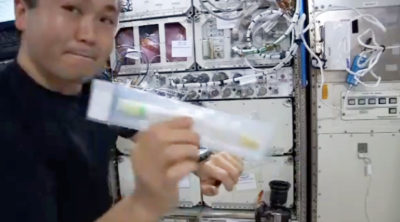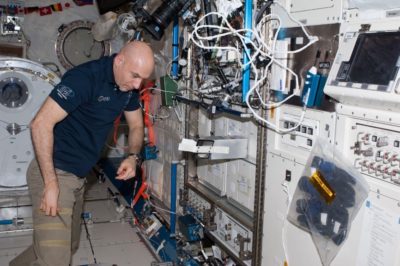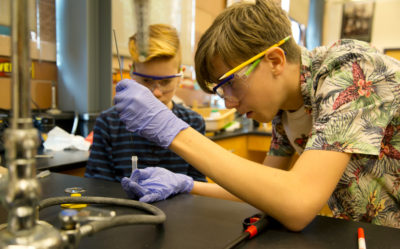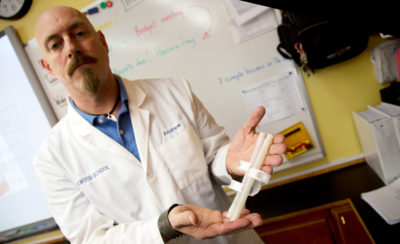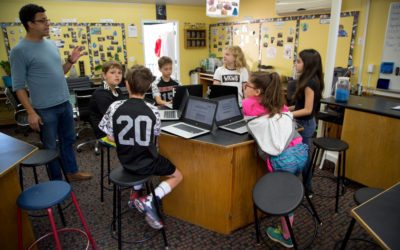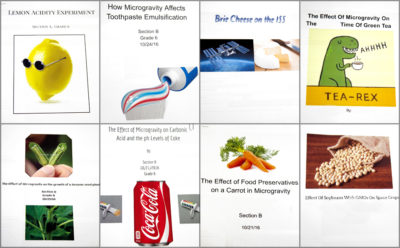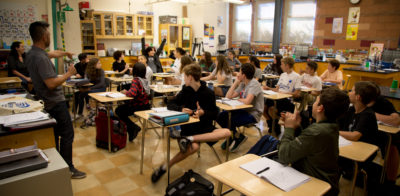Real Science, Real Challenges
For all the inspiration that the program brought with it, the other aspect of experiential learning—the part that mirrors real-world challenges and the trial and error of risk taking—was also present as the students settled in to create their proposals.
As Melanie shared, “It’s a long process and doing background research on things is tedious, but it’s very real, so there were definitely ups and downs for the kids, which we don’t necessarily see as a bad thing. By learning this way, they don’t get that false sense that answers are always immediate. This work can be boring, and there were days when they wanted it to be done. But, this is what real science is like, and they got to see that.”
Kari also believes that the Oakwood Space Program’s rigorous approach, which makes students ultimately responsible for idea refinement and project execution, is invaluable. “This way of learning is much better than having the students just reading from the textbook. They actually have the experience of creation and of student ownership. At the beginning, they started on this very high note but soon realized that this process was a roller coaster ride. Sometimes we dream too big and that’s ok. That’s when they figure out that they need to learn to manipulate things to fit the parameters. I congratulated my students the whole way. I pushed them and they pushed back in the best way and overcame so many challenges. They experienced real science and at the end, they were so proud.”
Working in groups, the kids had not only the challenges that any act of real-world scientific collaboration brings, but also a whole other set of unique challenges that the SSEP parameters require. First, the experiments have to be able to be conducted by astronauts who are hundreds of miles away, orbiting the planet. That means that the explanations to the astronauts who will carry out their experiments must be precisely articulated and meticulously constructed.
Second, the experiments need to be bold in ideas, but safe in execution. “There was one group of 5th graders,” Andrew recalls, “that wanted to see if things sublimate—go from a solid to a gas—in microgravity. This is a great question, but they wanted to test it with iodine and zinc pellets. But, this creates a reaction that you just can’t have onboard the International Space Station.” Since this combination could produce toxic fumes that would prove harmful to the testing environment, he sent them back to the drawing board and, “After a long search, they found a substitute: naphthalene. Mothballs. That was perfect. You could put a mothball in the tube, mass it before it goes up into space, mass it again when it comes back to see if there is any loss in mass. Sometimes you have to kind of guide them in different ways, but we’re really not allowed to give them ideas. They have to figure all of this out on their own.”
A third challenge came in the requirement that these experiments should somehow be designed to help the scientific community at large. Student finalist Miller reported on this aspect of the project, “My partner and I put a lot of thought into what we would choose to be sent up to the space station. It would have to be extremely useful in space, while also having a large body of research on it that we could use to back up our claim. This was one of the hardest parts of building our proposal, but we ended up proud of our choice: lima beans. They’re small and easy to transport, and like any other plant, can produce oxygen, something needed by astronauts.”
One of the greatest limitations faced by these student scientists is one of sheer size, or rather lack of size, of the container in which their experiments must fit. “When Phu first told us about this program we were imagining something like a shoe box,” said Andrew, “so you can imagine how we had to readjust when we saw what we were really working with.” The container, or FME (Fluids Mixing Enclosure) is very small, measuring just 7 inches long and with a ½ inch diameter. This size restriction meant that the students needed to figure out ways to make their big ideas take small forms.
Another challenge, perhaps the most significant, involved students getting comfortable with the idea that they wouldn’t be able to necessarily see the details of their experiment as it was being conducted. While the students here on Oakwood’s campus will have contact, through their written instructions, with the astronauts onboard the ISS, they won’t have the visibility of real-time reactions like one might see in a science lab. Therefore, the proposals must be constructed in such a way that they have a before and an after to measure. “This is an abstract idea for students,” said Melanie, “and I can’t tell you how many times I said, ‘Your idea is really good, but . . . what are you going to measure?’”
Challenges such as these were worth it in the end, says 8th grader Noah. “Doing science like this has really helped me with my confidence,” he said. “Now I know that nothing is so hard that it can’t be done. This has been a great opportunity.”
Seventh grader Gabrielle agrees, “There were certain complications and times I felt like, ‘I give up, I’m just not going to do this,’ and there were other times when I thought, ‘Wow, this could really go somewhere,’ but it wasn’t necessarily a party the whole way through . . . but to see that it all worked out, it really inspired me.”


